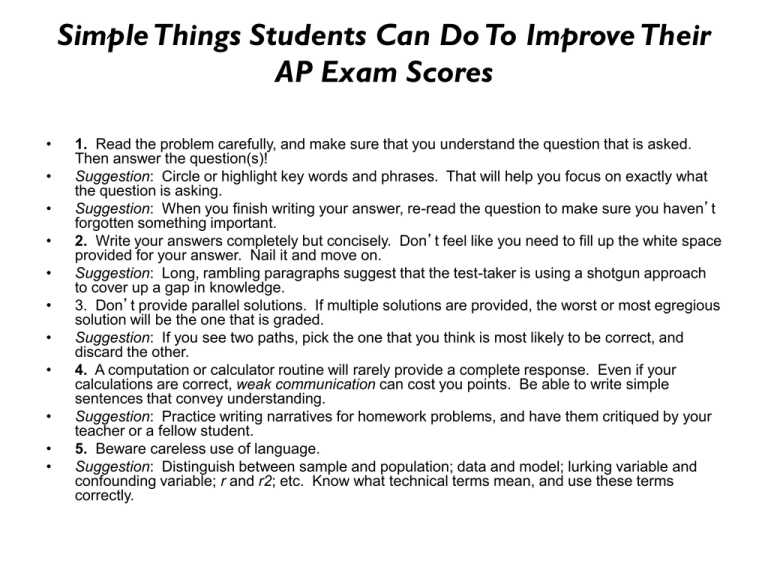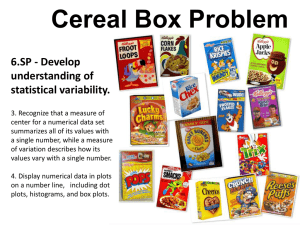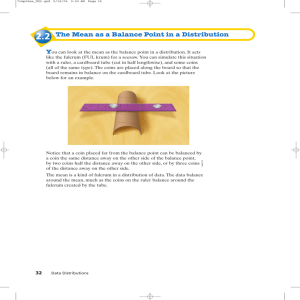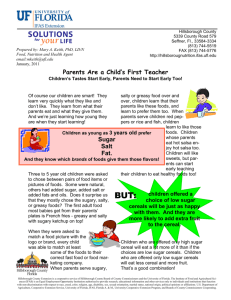Simple Things Students Can Do To Improve Their AP Exam Scores
advertisement

Simple Things Students Can Do To Improve Their AP Exam Scores • • • • • • • • • • • 1. Read the problem carefully, and make sure that you understand the question that is asked. Then answer the question(s)! Suggestion: Circle or highlight key words and phrases. That will help you focus on exactly what the question is asking. Suggestion: When you finish writing your answer, re-read the question to make sure you haven’t forgotten something important. 2. Write your answers completely but concisely. Don’t feel like you need to fill up the white space provided for your answer. Nail it and move on. Suggestion: Long, rambling paragraphs suggest that the test-taker is using a shotgun approach to cover up a gap in knowledge. 3. Don’t provide parallel solutions. If multiple solutions are provided, the worst or most egregious solution will be the one that is graded. Suggestion: If you see two paths, pick the one that you think is most likely to be correct, and discard the other. 4. A computation or calculator routine will rarely provide a complete response. Even if your calculations are correct, weak communication can cost you points. Be able to write simple sentences that convey understanding. Suggestion: Practice writing narratives for homework problems, and have them critiqued by your teacher or a fellow student. 5. Beware careless use of language. Suggestion: Distinguish between sample and population; data and model; lurking variable and confounding variable; r and r2; etc. Know what technical terms mean, and use these terms correctly. Simple Things Students Can Do To Improve Their AP Exam Scores • • • • • • • 6. Understand strengths and weaknesses of different experimental designs. Suggestion: Study examples of completely randomized design, paired design, matched pairs design, and block designs. 7. Remember that a simulation can always be used to answer a probability question. Suggestion: Practice setting up and running simulations on your TI-83/84/89. 8. Recognize an inference setting. Suggestion: Understand that problem language such as, “Is there evidence to show that … ” means that you are expected to perform statistical inference. On the other hand, in the absence of such language, inference may not be appropriate. 9. Know the steps for performing inference. – – – – • • • hypotheses assumptions or conditions identify test (confidence interval) and calculate correctly conclusions in context Suggestion: Learn the different forms for hypotheses, memorize conditions/assumptions for various inference procedures, and practice solving inference problems. 10. Be able to interpret generic computer output. Suggestion: Practice reconstructing the least-squares regression line equation from a regression analysis printout. Identify and interpret the other numbers. The Hardest (<50% correct) Multiple Choice Questions from the 2002 AP Statistics Exam • 9. (39% correct) A volunteer for a mayoral candidate’s campaign periodically conducts polls to estimate the proportion of people in the city who are planning to vote for this candidate in the up coming election. Two weeks before the election, the volunteer plans to double the sample size in the polls. The main purpose of this is to (A) reduce nonresponse bias (B) reduce the effects of confounding variables (C) reduce bias due to the interviewer effect (D) decrease the variability in the population (E) decrease the standard deviation of the sampling distribution of the sample proportion • 9. Answer: (E) The standard deviation of the sampling distribution is . If the sample size is increased, then the value of this fraction will decrease. • (A) (B) (C) (D) (E) 10. (37% correct) The lengths of individual shellfish in a population of 10,000 shellfish are approximately normally distributed with mean 10 centimeters and standard deviation 0.2 centimeter. Which of the following is the shortest interval that contains approximately 4,000 shellfish lengths? 0 cm to 9.949 cm 9.744 cm to 10 cm 9.744 cm to 10.256 cm 9.895 cm to 10.105 cm 9.9280 cm to 10.080 cm 10. Answer: (D) The "shortest interval" tells me to use a symmetric interval about the mean, µ = 10. If 4,000 out of 10,000 will be IN the interval, then 6,000 out of 10,000 will be OUTSIDE the interval. So there is 0.3 area under the curve and ABOVE the interval I'm looking for, and 0.3 area BELOW the interval. TI-83: invNorm(.7,10,.2) = 10.105, and invNorm(.3,10,.2) = 9.895. Hence the shortest interval containing 4,000 shellfish is (9.895, 10.105). • I. II. III. (A) (B) (C) (D) (E) 18. (29% correct) Which of the following statements is (are) true about the t-distribution with k degrees of freedom? The t-distribution is symmetric. The t-distribution with k degrees of freedom has a smaller variance than the t-distribution with k + 1 degrees of freedom. The t-distribution has a larger variance than the standard normal (z) distribution. I only II only III only I and II I and III 18.Answer: (E) The t-distribution is shorter at the center (mean) and has more area in the tails. Statement II is wrong because as the sample size increases, the t–distribution approaches the normal distribution, and has less area in the tails, and hence a smaller variance. Ten Lessons Learned from the AP Reading #10: Read the question--twice! 2008 AP Exam, Free Response Question 1 To determine the amount of sugar in a typical serving of breakfast cereal, a student randomly selected 60 boxes of different types of cereal from the shelves of a large grocery store. The student noticed that the side panels of some of the cereal boxes showed sugar content based on one-cup servings, while others showed sugar content based on threequarter-cup servings. Many of the cereal boxes with side panels that showed three-quarter-cup servings were ones that appealed to young children, and the student wondered whether there might be some difference in the sugar content of the cereals that showed different-size servings on their side panels. #10: Read the question--twice! To investigate the question, the data were separated into two groups. One group consisted of 29 cereals that showed one-cup serving sizes; the other group consisted of 31 cereals that showed three-quarter-cup serving sizes. The boxplots display sugar content (in grams) per serving of the cereals for each of the two serving sizes. #10: Read the question--twice! 2008 AP Exam, Free Response Question 1 To determine the amount of sugar in a typical serving of breakfast cereal, a student randomly selected 60 boxes of different types of cereal from the shelves of a large grocery store. The student noticed that the side panels of some of the cereal boxes showed sugar content based on one-cup servings, while others showed sugar content based on threequarter-cup servings. Many of the cereal boxes with side panels that showed three-quarter-cup servings were ones that appealed to young children, and the student wondered whether there might be some difference in the sugar content of the cereals that showed different-size servings on their side panels. #10: Read the question--twice! To investigate the question, the data were separated into two groups. One group consisted of 29 cereals that showed one-cup serving sizes; the other group consisted of 31 cereals that showed three-quarter-cup serving sizes. The boxplots display sugar content (in grams) per serving of the cereals for each of the two serving sizes. #9: Answer the question! (a) Write a few sentences to compare the distributions of sugar content per serving for the two serving sizes of cereals. Shape 1-cup: Left skewed ¾-cup: Roughly symmetric Center More sugar for 1-cup cereals than ¾-cup cereals (medians are 13g & 10g) Spread More variability for 1-cup cereals than ¾-cup cereals (IQRs are 11g & 4 g) #8: Don’t shoot yourself in the foot! • Shape – Skewed which way? – “Normal”?! • Center – Mean?! • Spread – Standard deviation?! #7: Avoid calculator speak (1) Binompdf(12,.2,3) = no full credit • Better: P(X = 3) = (12C3)(0.2)3(0.8)9 • OK: binompdf with n = 12, p = .2, k = 3 (2) Normalcdf(90,105,100,5) = no full credit • Better: draw, label, shade Normal curve • OK: normalcdf with low bound = 90, high bound = 1-5, mean = 100, std. dev. = 5 #6: Naked answer = no credit • Directions: Show all your work. Indicate clearly the methods you use, because you will be graded on the correctness of your methods as well as on the accuracy and completeness of your results and explanations. From 2008 Exam, FR Question 3 • “Calculate the expected score for each player.” • “Find the probability that the difference in their scores is -1.” #5: Know your inference methods 2008 AP Exam, Free Response Question 5 A study was conducted to determine where moose are found in a region containing a large burned area. A map of the study area was partitioned into the following four habitat types. (1) Inside the burned area, not near the edge of the burned area, (2) Inside the burned area, near the edge, (3) Outside the burned area, near the edge, and (4) Outside the burned area, not near the edge. The study area The figure below shows these four habitat types. The proportion of total acreage in each of the habitat types was determined for the study area. Aerial survey results Using an aerial survey, moose locations were observed and classified into one of the four habitat types. The results are given in the table below. #5: Know your inference methods (a) The researchers who are conducting the study expect the number of moose observed in a habitat type to be proportional to the amount of acreage of that type of habitat. Are the data consistent with this expectation? Conduct an appropriate statistical test to support your conclusion. Assume the conditions for inference are met. #5: Know your inference methods • What percent of students at your school have a MySpace page? • Is there a relationship between students’ favorite academic subject and preferred type of music at a large high school? • Helpful web site: INSERT URL #4: Don’t skip the investigative task Part B Question 6 Spend about 25 minutes on this part of the exam. Percent of Section II score—25 #3: Beware mandatory deductions • Saying “experiment” for an observational study • “Confounding” when there isn’t • Using incorrect symbols: eg statistics in a hypothesis #2: Only use terms and symbols you know • It’s better to explain in your own words than to use a technical term incorrectly • If you’re unsure about notation, use words instead of symbols #1: Don’t write too much • Answer the question, then shut up! • Space provided is more than enough • Remember the mandatory deduction rule Ten Lessons Learned: Recap #10: Read the question--twice! #9: Answer the question! #8: Don’t shoot yourself in the foot! #7: Avoid calculator speak #6: Naked answer = no credit #5: Know your inference methods #4: Don’t skip the investigative task #3: Beware mandatory deductions #2: Only use terms and symbols you know #1: Don’t write too much






